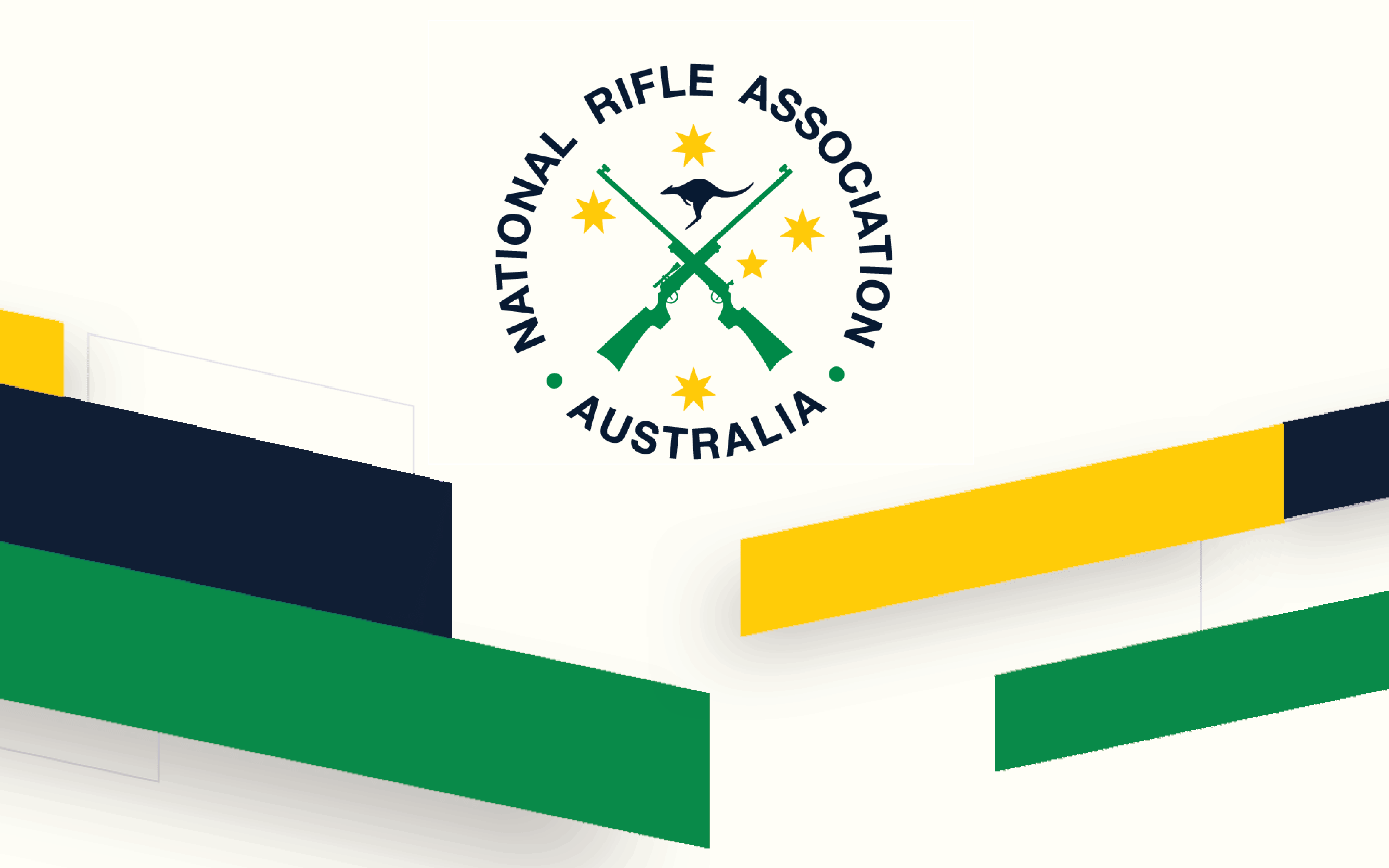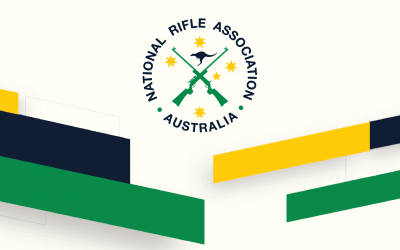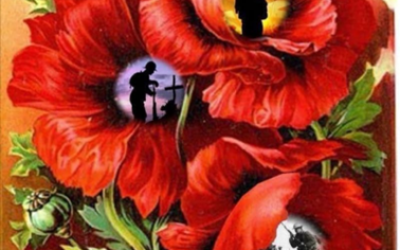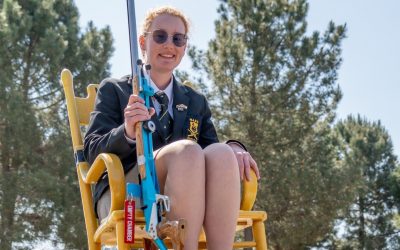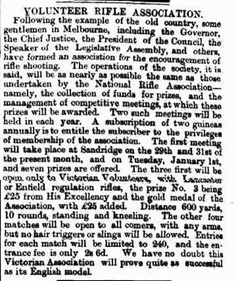
The first movement towards the formation of the Victorian Rifle association appear in a newspaper Letter to the Editor[1] of 1st October 1860 in The Argus. The writer naming himself as “Kent” suggests that a rifle association be formed along the lines of the national association formed in England.
Another article from the Bendigo Advertiser[2] of the 12th October 1860 refers to a letter “that promulgates the idea of a rifle association”.
No further newspaper references can be found until the 14th of December 1860[3] where there is a confirmation of the newly formed Victorian Rifle Association naming the members of the Committee many of whom appear to have moved in the same social or political circles.
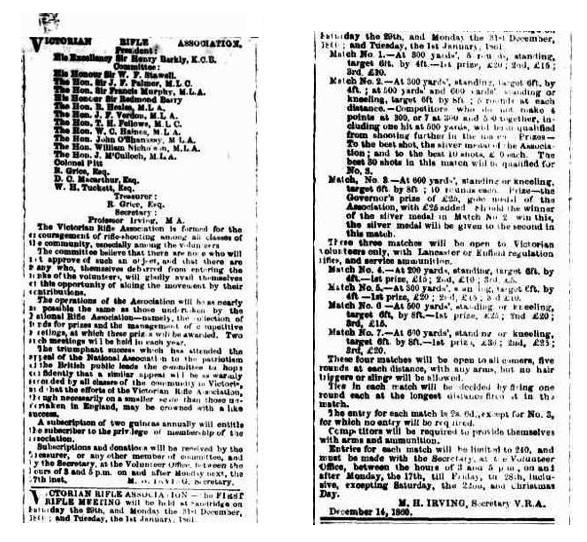
At the same time as announcing the members of the newly formed committee around the 14th of December 1860 the Committee also announced that the VRA’s First Rifle Meeting would be held in just a matter of weeks on Saturday the 29th, Monday the 31st of December 1860 and Tuesday the 1st of January 1861.
This was much faster than the infant NSW Rifle Association that, while formed a month or 2 earlier, formally advertised their First Rifle Meeting for August 1861 then delaying it until September 1861. Initial indications were that the rifle meeting would be held for the Queen’s Birthday (May 1861) perhaps as a show of patriotism but this did not come to fruition.
Like the NSW Rifle Association, the first VRA Committee was a collection of mostly politicians with similar reasons to support volunteer forces in the defence of the Colony. From the 1850s there was a rising interest in raising volunteer forces and the imminent departure of British forces in 1870 were to leave the Colony of Australia to provide for its own defence.
President
Sir Henry Barkly [4]
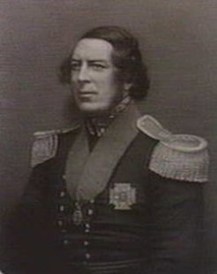
Sir Henry Barkly was born in 1815 in Middlesex, England. Initially beginning a career in business Henry was elected to the House of Commons in 1845-48 representing Leominster.
He was appointed Governor and Commander in Chief of British Guiana and in 1853 Governor of Jamaica. In both positions he was considered successful.
In 1856 Henry was appointed Governor of Victoria stepping in as a “cautious and constitutional”[5] governor over early Victorian politics. He took great interest in promoting the colonial defence forces.
In 1863, Sir Henry ended his term in Victoria and took up the position of Governor of Mauritius and then to be Governor to the Cape of Good Hope being appointed in 1870. In 1876, Henry returned to England into retirement after a successful career, passing away in 1898. The Barkly Tablelands in Queensland are named in his honour.
Committee
Sir William Foster Stawell[6]
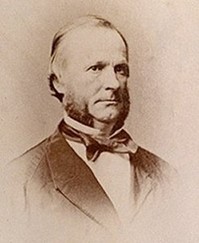
Sir William Stawell (Pronounced ‘Stowell’) was born in County Cork, Ireland in 1815, the son of a barrister, Jonas Stawell and his wife Anna who was the daughter of the Bishop of Cork, Kilmore and Clogher. He practised law in England Ireland before emigrating to Australia in 1842. He was admitted to the Port Phillip District Bar in 1843 and built a large practice.
He was an advocate for separation from New South Wales and in 1851 was nominated Crown member in the first Legislative Council doing much of the work to establish a court system for Victoria.
Sir William was appointed Chief Justice in 1857 and was respected for his impartiality.
As Chairman of the Exploration Committee of the Royal Society he oversaw the arrangements for the Bourke and Wills Expedition. He resigned as Chief Justice in 1886 and was then appointed Lieutenant Governor. In 1889 he and his wife sailed for England and Sir William died suddenly at Naples along the way. The town of Stawell in Victoria is named for him.
Sir James Frederick Palmer MLC[7]
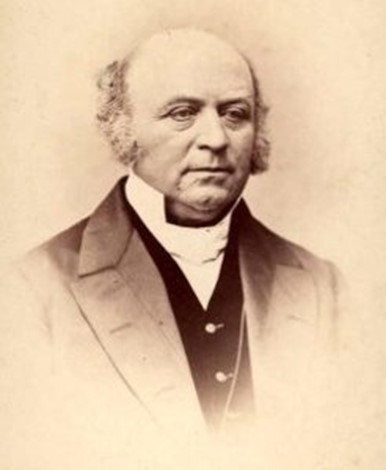
Sir James Palmer was a medical practitioner later becoming a politician. Born in 1803 in Devon, England to the Rev. John Palmer and his wife Jane. He undertook medical training with Dr John Gunning surgeon in chief of the army and in 1824 became house surgeon at St George’s Hospital, later practising in London before becoming senior surgeon at St James’s Dispensary.
Missing out on vacant surgical appointments, Palmer emigrated to Victoria in 1840 and registered in 1842 as a medical practitioner.
Sir James had interests in setting up a cordial factory, wine merchants and pastoral estates as well as having a Punt across the Yarra River.
By 1845 he was Mayor of Melbourne and in 1848 he was elected to the Legislative Council of NSW resigning in 1849. In 1851 he was returned to the Victorian Legislative Council. Sir James had other interests including the Public Library, and the foundation of Melbourne Hospital as well as being an Anglican Layman.
Sir James died in 1871.
Sir Francis Murphy MLA[8]
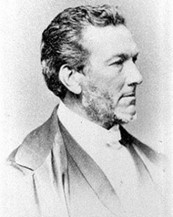
Sir Francis was born in Cork, Ireland in 1809 son of Sir Francis Down Murphy who was head of the Cork Convict Transport Department. After completing his education as a doctor in 1835, Francis emigrated to Sydney in 1836 and in 1837 was appointed colonial surgeon to the Bungonia district of NSW by Governor Bourke. After acquiring land, Francis gave up his medical career to become a successful pastoralist. He sat on the Goulburn Bench for 8 years and in 1846 moved to Port Phillip working a property on the Ovens River until he became a member of the Legislative Council.
Living in Collingwood he was a member of the East Collingwood Volunteer Rifles, rising the rank of Major.
In 1856 he took up the role of Speaker of the Legislative Assembly holding that post for 15 years. He was a member of the 1861 royal commission on Bourke and Wills as well as sitting by invitation on the commission that selected New Zealand capital.
Sir Francis retired from politics in 1871 travelling to Europe a number of times from 1876 to 1883 after which he lived in retirement. He died in 1891 in Melbourne aged 82.
Sir Redmond Barry[9]
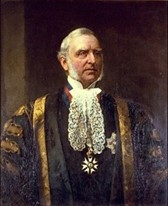
Redmond Barry was born in County Cork in Ireland in 1813 the son of Major General Henry Barry.
Redmond’s education was chosen to prepare him for the military but was unable to find a commission. In the interim he continued his education, graduating from trinity College and then admitted to the Irish Bar in 1838. Our reference suggests that the Irish Bar was overcrowded and that following the death of his father, and little prospect of earning an income he emigrated to Australia.
An affair with a married woman on the voyage saw him confined to his cabin by the ship’s cabin.
Landing in Sydney he later sailed for Melbourne where he began practising law. In 1841 he was admitted to practice in the Supreme Court in Melbourne.
Appointed the First Solicitor General of Victoria in 1851 and shortly after to the new bench of the Supreme Court of Victoria he presided over the trials of most of the Eureka Stockade rebels in 1855 and his most famous case being that of the trial of Ned Kelly in 1880.
Redmond Barry was involved in many organisations, such as the Melbourne Polo Club, Royal Melbourne Hospital, Royal Society of Victoria, State Library of Victoria, Discharged Prisoner’s Aid Society amongst others. He held a commission in the Victorian Volunteers Militia.
Sir Redmond Barry died after a short illness in 1880 just 12 days after the execution of Ned Kelly.
Richard Heales MLA[10]
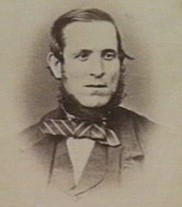
Richard Heales was born in London, 1821 and was known as a politician and temperance reformer.
Richard served an apprenticeship as a coach builder and emigrated to Australia in 1842 as Bounty Immigrants.
In 1843 he was Secretary of the Total Abstinence Society with his father, also Richard the President. In 1850 he entered Melbourne City Council and successfully proposed that holding council elections in Public Houses be discontinued.
In 1856 he stood for the seat of Melbourne in the Legislative Assembly and failed to win. In 1857 he won a by-election for East Bourke. He stood for setting aside land for agriculture and not for speculators. In 1860, Heales rose to prominence after a turbulent period of politics and led the government for a short period. In 1864 he was granted leave from Parliament for health reasons and died aged 42 of tuberculosis. The suburb of Healesville is named for him.
George Frederic Verdon MLA[11]
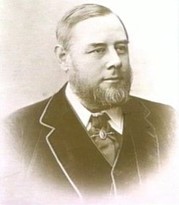
George Verdon was born in Lancashire, England in 1834, the son of a Clergyman from Dublin. At age 17 he sailed to Australia with a letter of introduction to Sir James Palmer a member of the Victorian Parliament.
He briefly spent time in the gold diggings at Campbell’s Creek without success and next took up a position in business after which he set up his own Ship’s Chandlers in Williamstown. He joined and the volunteer militia in 1854 and in 1857 commanded the Williamstown Company that was called out in 1857 to deal with a Convict uprising that had resulted in the killing of a convict supervisor.
He entered politics in 1859 winning the seat of Williamstown becoming Treasurer in the Heales ministry in 1860. In 1866 he visited London and obtained HMS Nelson from the Colonial Secretary as a training ship and placed £100,000 towards the cost of a monitor Cerberus. In 1867 he was appointed a director of the Victorian Board of the English, Scottish and Australian Chartered Bank. While he spent many years in the banking sector he had both successes and failures. He had an interest in the arts and in particular, astronomy. George Verdon died in 1896.
Thomas Howard Fellows MLC[12]

Thomas Fellows was born in 1822 in Hertfordshire, the son of a solicitor. He went to school and Eton College and later worked with his father. Thomas was a successful rower belonging to the Leander Club that rows on the Thames.
Thomas arrived in Melbourne in 1853 and admitted to the Victorian Bar. In 1854 he was first elected to the Victorian Legislative Council as member for Loddon. During his political career, he held positions as Solicitor General, Attorney General and Postmaster General.
In 1872 he became the 5th Judge of the Supreme Court of Victoria.
Thomas Fellows died at age 55 in 1878.
William Clark Haines MLA[13]
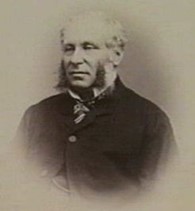
Born in 1810, Hampstead in England William Haines and was a practising surgeon up until 1842 when he migrated to Victoria and bought property near Geelong in a partnership.
Haines was well known as a territorial magistrate in the Geelong District and in 1851 was a nominee in the first Legislative Council but resigned in protest in 1852 when he was against the issue of land to squatters.
He was elected member for Grant in the council of 1853.
In 1854 Haines was appointed Colonial Secretary in which role he was acknowledged by the Governor Sir Charles Hotham..
In the first Parliament, Haines led the first ministry but was in and out of office several times in the 1850s and then returned again in the 1860s. A contemporary journal described him as “a man of no brilliant talents but of immense weight of character—honest, jovial, undisguised old English Tory”.
William Haines died in 1866.
Sir John O’Shanassy MLA[14]
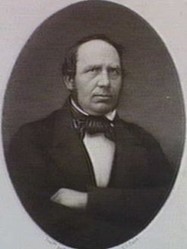
Born in 1818 at Ballinahow, Ireland John was apprenticed to a draper and wine and spirits merchant after his father passed away in 1831. He emigrated to Australia a settled to a property near Melbourne but later moved to the city and opened a drapers shop.
He began a career in politics in 1846 becoming a member of the Melbourne Council at a by-election only to be defeated at the next election. He was one of 12 members selected as a commissioner to look into the goldfields just before the Eureka rebellion. Later in 1855 the commissioners found their recommendations vindicated the miners grievances.
O’Shannassy continued in politics serving in both the Victorian Upper and Lower Houses as well as a short term as premier. He was a separatist and anti-transportationist as well as an Irish and Catholic community leader.
John O’Shannassy died in 1883 aged 65.
William Nicholson MLA[15]
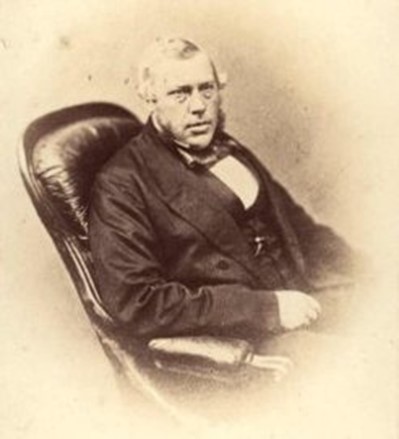
William Nicholson was born in 1816 in Whitehaven, England, the son of a farmer.
Migrating to Australia in 1842 he began business as a retail grocer eventually becoming W. Nicholson and Co.
His political career began after being elected to Melbourne City Council in 1848, and an Alderman in 1850 and Mayor for a year.
He returned to England for 2 years in 1856 but it was not until 1859 that he was able to return to a life in politics winning a seat in the Legislative Assembly and was Premier from October 1859 to November 1860.
After an illness in 1863 he was no longer active in politics and died in 1865.
A biographer gives, He was ‘a plain plodding fellow’; good-natured, candid and self-confident, he took pleasure in his wealth and position and the knowledge that he was self-made. In many ways he was typical of the radical merchant of his day.
Sir James McCulloch MLA[16]

Sir James McCulloch KCMG (1819–1893) served four separate terms as premier of Victoria between 1863 and 1877. Born in Glasgow, he came to Australia in 1853 having become a junior partner in the merchant firm J & A Dennistoun, a branch of which he established in Melbourne. He soon became a leading figure in the colonial business community, twice serving as president of the Melbourne Chamber of Commerce; forming a new company, McCulloch, Sellar & Co; and also acquiring property. He was elected to the first Legislative Assembly in 1856. A supporter of landowners’ interests, McCulloch’s dissatisfaction with legislation proposing to raise pastoral rents led him to help overthrow the administration of Charles Gavan Duffy in 1863. McCulloch became premier and chief secretary in June that year, fulfilling both roles until 1869. He became premier for the third time in 1870, shortly after being knighted. Resigning his seat amidst difficulties relating to trade tariffs and property tax, he acted as agent-general in London during 1872–1873, returning to the Victorian parliament as member for Warrnambool in 1874. McCulloch was premier again (and treasurer) from October 1875 until 1877. After leaving politics, he concentrated on his directorships with companies including the Bank of New South Wales and the London Chartered Bank. He was a trustee of the Public Library, Museum, and National Gallery from 1870 until 1886, in which year he returned to England.
(the above biography taken directly from an article on the National Portrait Gallery website.)
Richard Grice – VRA Committee Member and Treasurer[17]

Richard Grice was born in Cumberland, England in 1813. His family had for may generations been farmers and businessmen in the Cumberland district and he learned farming experience on the family properties.
In 1839 Richard arrived in Port Adelaide with a business partner Benjamin Heape and two shepherds then went on to Melbourne where they set up business in pastoral pursuits as well as import and export.
Grice was speared in the back by aboriginals while along the Goulburn River.
After Heape returned to England in 1852 Grice went into partnership with T.J. Sumner becoming one of the foremost mercantile houses in the colonies. The firm also held large stations in Victoria, NSW, South Australia and Queensland.
He was a director of the Union Bank and had interest in supporting the Melbourne Hospital, the Melbourne Benevolent Asylum and financially supported the St Marks Church in Fitzroy.
Richard Grice passed away in 1882.
David Charteris McArthur[18]
David McArthur was born in 1808 in Gloucester, England and was educated in Scotland, working in an insurance company. He joined the Bank of Australasia in 1835 when it opened in Sydney.
In 1838 he moved to Melbourne to open a branch there which quickly grew to rival Sydney’s head office. In the 1850s gold rush period he opened numerous branches in the Goldfields. He also travelled to New Zealand visiting the bank’s interests there.
McArthur was retired by the London directors in 1876, with a trip to England and an annuity.
He is said to have been kind, tactful, conscientious and honest. McArthur was also said to be “inclined to see Melbourne as the hub of the universe”.
David McArthur died in 1887 at his home.
William Henry Tuckett[19]
Not much is found on William Tucket. The below is the text version of the obituary printed in The Argus, Melbourne, 20th September 1904.
DEATH OF MR. W. H. TUCKETT.
The death of Mr. W. H. Tuckett, which took place at his residence, Burnett street, St. Kilda, yesterday morning removes a familiar figure in city circles, and will be sincerely regretted by his many friends, especially by old colonists, among whom he was one of the oldest. Notwithstanding his advanced age, he was in the enjoyment of fairly good health until about three months ago, when his physical strength began to fail, death resulting as already stated. He was attended throughout his last illness by Mr. James Eadie, M.B.
Mr. Tuckett was born at Bristol in 1817, and after a residence at Newfoundland in a merchant’s office, he returned to England, and embarked for Australia by the ship Wardshipton, arriving at Melbourne in 1841. He found employment on the day of his arrival at Mr Henry Batman’s general store at the south west corner of Collins and William Street, and subsequently accepted a position offered him by Messrs Edward Westby and Company, general merchants, in Flinders-lane on the site of Messrs. Paterson, Laing and Bruce’s warehouse. A few months later he was admitted as a partner and continued as such in the conduct of a lucrative business until 1860 when the firm was dissolved. He then turned his attention to pastoral pursuits on the Springbank Station near Casterton with disastrous financial result to himself and in 1868 he returned to Melbourne and founded the firm of Messrs. W. H. Tuckett and Sons, accountants and auditors, from which he retired in 1900, leaving the business to his sons Messrs. C. H. & P. Tuckett.
Although Mr Tuckett never entered either civic or political life, he took an active interest in the affairs of the state. He was chairman of directors of the Melbourne, Mount Alexander and Murray River Rail-way Company, which was formed in 1853, and which received Government grants of land for the purpose of railway construction from Melbourne to Echuca, Melbourne to Geelong and Melbourne to Williamstown.
The work was begun at both at Melbourne & Williamstown, and the line constructed as far as the Saltwater River on the Melbourne side, but owing to the repeated failures to span the river, the company was in 1856 placed in liquidation, and taken over by the Government who paid off the shareholders in cash, less 5 per cent discount instead of debentures at par.Mr Tuckett was a member of the Yeomanry Cavalry, and when the Imperial troops were sent from Melbourne about 1860 to take part in the Maori War in New Zealand it fell to the lot of the cavalry to mount guard at the Treasury in Queen Street, Government House, Toorak, and the powder magazine, then situated beyond Batman’s Hill (now Flinders-street westward from Spencer Street). The Guard at the Treasury consisted of Messrs. W. J. Clarke (after-wards Sir William Clarke), W.H Tuckett J. S. Butters, C. W. Umphelby, W. Close, and J. Jamieson.
In business and financial circles Mr. Tuckett was highly esteemed for his shrewd business capacity and undoubted probity.
He was a director of the Bank of Victoria in the early days of its operations and also of other financial institutions. Among the institutions of which he was auditor were the National and Commercial banks, the Australian Mutual Provident Life Insurance Company, Messrs. Goldsbrough’s and, in the old days, the Hobson’s Bay Railway Company.
Mrs Tuckett predeceased her husband on October 5 last year. There is a family of five daughters and two sons. Three of the daughters are married namely, Mrs John Young, Mrs. R .Strahan (of Adelaide) and Mrs W.J. Anderson.
The funeral will take place tomorrow afternoon at the St Kilda Cemetery.
William Tucket died in 1904 in St Kilda, Melbourne.
Secretary
Professor Martin Howry Irving M.A.[20]
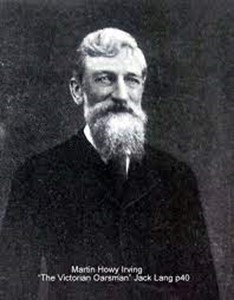
Martin Irving was born in London in 1831, his father a noted Scots Preacher Edward Irving declared a heretic by the Church of Scotland and founded the Irvingite or Catholic Apostolic Church.
Martin was a good scholar, going to Kings College School in London and winning a Balliol College Scholarship.
In 1855 he was selected to take up a position at the University of Melbourne teaching Greek, Latin, logic and English.
In 1875 he purchased Hawthorn Grammar School, doubling numbers in the first year and later becoming one of the biggest schools in the colony.
He led a caucus of schoolmasters who constantly challenged Sir Redmond Barry, Chancellor of Melbourne University. The caucus also caused the resignation of William Stawell from the Chancellorship.
In 1884 he was one of three foundation commissioners of the Public Service Board of Victoria.
An expert rifle shot, he encouraged the sport in schools. He joined the Volunteer Rifles in 1862 rising to Lieutenant Colonel in charge of the First Battalion Victorian Militia 1884-1890. Described as large and athletic, Martin Irving was successful in sculls and founded the Melbourne Boat Club in 1859, stroking the fours.
Returning to England in 1900 and died in 1912 at his home in Albury, Surrey.
References:
[1] https://trove.nla.gov.au/newspaper/article/5690744?searchTerm=rifle%20association
[2] https://trove.nla.gov.au/newspaper/article/87947213?searchTerm=%22rifle%20association%22
[3] https://trove.nla.gov.au/newspaper/article/5695023?searchTerm=victorian%20rifle%20association
[4] https://adb.anu.edu.au/biography/barkly-sir-henry-2936
[5] https://trove.nla.gov.au/newspaper/article/9857271?searchTerm=henry%20Barkly
[6] https://adb.anu.edu.au/biography/stawell-sir-william-foster-4635
[7] https://adb.anu.edu.au/biography/palmer-sir-james-frederick-4358
[8] https://adb.anu.edu.au/biography/murphy-sir-francis-4275
[9] https://adb.anu.edu.au/biography/barry-sir-redmond-2946
[10] https://adb.anu.edu.au/biography/heales-richard-3742
[11] https://adb.anu.edu.au/biography/verdon-sir-george-frederic-4776
[12] https://en.wikipedia.org/wiki/Thomas_Howard_Fellows
https://new.parliament.vic.gov.au/members/thomas-fellows/
[13] https://adb.anu.edu.au/biography/haines-william-clark-3688
[14] https://adb.anu.edu.au/biography/oshanassy-sir-john-4347
[15] https://adb.anu.edu.au/biography/nicholson-william-4300
[16] https://www.portrait.gov.au/portraits/2016.7/a-victorian-knight-thrice-chief-secretary-sir-james-mcculloch-kcmg )
[17] https://adb.anu.edu.au/biography/grice-richard-3669
[18] https://adb.anu.edu.au/biography/mcarthur-david-charteris-4058
[19] https://trove.nla.gov.au/newspaper/article/10340963
[20] https://adb.anu.edu.au/biography/irving-martin-howy-3840

